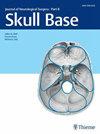Surgical Approaches to Resection of Olfactory Groove Meningiomas: Comparative Meta-Analysis of the Endoscopic Endonasal versus Transcranial and Unilateral versus Bilateral Approaches
IF 0.9
4区 医学
Q3 Medicine
引用次数: 0
Abstract
Here we systematically review the extant literature to highlight the advantages of bilateral versus unilateral approaches and endoscopic endonasal (midline) approaches versus transcranial approaches for olfactory groove meningiomas, focusing on complications, extent of resection, and local recurrence rates. Methods Three databases were queried to identify all primary prospective trials and retrospective series comparing outcomes following endoscopic endonasal versus transcranial approaches and unilateral versus bilateral craniotomy for surgical resection of olfactory groove meningiomas. All articles were screened by two independent authors and selected for formal analysis according to predefined inclusion/exclusion criteria. Results: Seven studies comprising 288 total patients (mean age 55.0 ± 24.6 years) met criteria for inclusion. In the three comparing the endoscopic endonasal (n=21) versus transcranial (n=32) approaches, there was no significant difference between the two with respect to gross total resection (p=0.34) or rates of Simpson Grade 1 resection (p=0.69). EEA demonstrated higher rates of overall complications (p<0.01) including postoperative infection (p=0.03). In the four studies comparing bilateral (n=117) versus unilateral approaches (n=118), overall complication rates (p<0.01) and disease recurrence (p=0.01) were higher with bilateral approaches. All surgery-related mortalities also occurred in the bilateral cohort (n=7, 7.14%). Gross total resection (p=0.63) and Simpson grade (p=0.48) were comparable between approaches. Olfaction preservation was superior for unilateral approaches (p<0.01). Conclusions Though the literature is limited, current evidence suggests that the EEA may be favorable over conventional craniotomy for select olfactory groove meningioma patients. Where craniotomy is used, unilateral approaches appear to reduce complications and the risk of olfaction loss嗅沟脑膜瘤切除手术方法:鼻内镜与经颅、单侧与双侧手术方法的比较分析
在此,我们对现有文献进行了系统回顾,以突出双侧与单侧方法、内窥镜鼻内(中线)方法与经颅方法治疗嗅沟脑膜瘤的优势,重点关注并发症、切除范围和局部复发率。方法查询了三个数据库,以确定所有主要的前瞻性试验和回顾性系列研究,比较内窥镜鼻内入路与经颅入路以及单侧开颅与双侧开颅手术切除嗅沟脑膜瘤的结果。所有文章均由两位独立作者筛选,并根据预先确定的纳入/排除标准进行正式分析。结果:共有288名患者(平均年龄55.0 ± 24.6岁)参加的七项研究符合纳入标准。在三项比较内窥镜鼻内法(n=21)与经颅法(n=32)的研究中,两者在总切除率(p=0.34)或辛普森1级切除率(p=0.69)方面没有显著差异。EEA 的总体并发症发生率较高(p<0.01),包括术后感染(p=0.03)。在比较双侧入路(n=117)与单侧入路(n=118)的四项研究中,双侧入路的总体并发症发生率(p<0.01)和疾病复发率(p=0.01)更高。所有与手术相关的死亡率也都发生在双侧入路组中(7 例,7.14%)。两种方法的总切除率(p=0.63)和辛普森分级(p=0.48)相当。结论虽然文献资料有限,但目前的证据表明,对于特定的嗅沟脑膜瘤患者,EEA可能比传统开颅手术更有利。在使用开颅手术时,单侧入路似乎可减少并发症和嗅觉丧失的风险。
本文章由计算机程序翻译,如有差异,请以英文原文为准。
求助全文
约1分钟内获得全文
求助全文
来源期刊

Journal of Neurological Surgery Part B: Skull Base
CLINICAL NEUROLOGY-SURGERY
CiteScore
2.20
自引率
0.00%
发文量
516
期刊介绍:
The Journal of Neurological Surgery Part B: Skull Base (JNLS B) is a major publication from the world''s leading publisher in neurosurgery. JNLS B currently serves as the official organ of several national and international neurosurgery and skull base societies.
JNLS B is a peer-reviewed journal publishing original research, review articles, and technical notes covering all aspects of neurological surgery. The focus of JNLS B includes microsurgery as well as the latest minimally invasive techniques, such as stereotactic-guided surgery, endoscopy, and endovascular procedures. JNLS B is devoted to the techniques and procedures of skull base surgery.
 求助内容:
求助内容: 应助结果提醒方式:
应助结果提醒方式:


